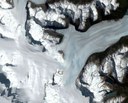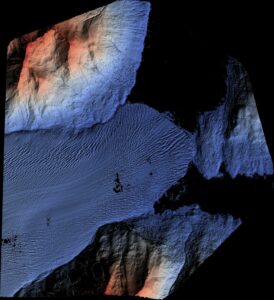Data can be obtained (free of charge) at two processing levels:
- Advanced users can obtained raw (“Sensor”) Pléiades stereo images from CNES / Airbus. The stereo-pair is provided with the rational polynomial coefficient (RPC) for DEM generation using open-source or commercial software.

- LEGOS also distributes DEMs and ortho-images derived automatically (without ground control point) using the Ames Stereo Pipeline [Beyer et al., Earth and Space Science, 2018]. The set of processing parameters used for DEM generation are from [Marti et al., TC, 2016] for block matching -BM- and from [Deschamps-Berger et al. TC, 2020] for semi global matching -SGM. DEMs are distributed at two resolutions (2 and 20 m) and provide ellipsoidal heights above WGS84 ellipsoid. A 0.5-m panchromatic and a 2-m multi-spectral (RGB+Near InfraRed) ortho-images are also delivered. Pléiades DEMs computed without ground control point have a relative accuracy of typically +/- 1 m over glacier terrain but the absolute accuracy is generally worse (Berthier et al., 2024, submitted). The whole DEM can be up to 5-10 m above or below the true earth surface and may be shifted horizontally by the same amount. It implies that proper 3D co-registration to reference data (other DEMs, ICESat) is mandatory.

References:
- Berthier et al.: The Pléiades Glacier Observatory: high resolution digital elevation models and ortho-imagery to monitor glacier change, EGUsphere [preprint], https://doi.org/10.5194/egusphere-2024-250, 2024.
- Beyer et al.: The Ames Stereo Pipeline: NASA’s Open Source Software for Deriving and Processing Terrain Data, Earth and Space Science, 5(9), 537–548, doi:10.1029/2018EA000409, 2018.
- Deschamps-Berger et al.: Snow depth mapping from stereo satellite imagery in mountainous terrain: evaluation using airborne laser-scanning data, The Cryosphere, 14(9),2925–2940, https://doi.org/10.5194/tc-14-2925-2020, 2020.
- Marti et al.: Mapping snow depth in open alpine terrain from stereo satellite imagery, The Cryosphere, 10(4), 1361–1380, doi:10.5194/tc-10-1361-2016, 2016.
